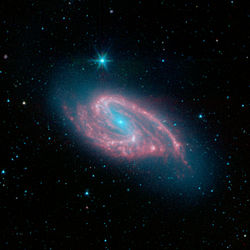| Messier 66 | |
|---|---|
 A colour-composite image of M66 | |
| Observation data (J2000 epoch) | |
| Constellation | Leo |
| Right ascension | 11h 20m 15.026s [1] |
| Declination | +12° 59′ 28.64″ [1] |
| Redshift | 0.002425±0.000010 [2] (696.3±12.7 km/s) [3] |
| Distance | 31 Mly (9.6 Mpc) [4] |
| Apparent magnitude (V) | 8.9 [2] |
| Characteristics | |
| Type | SAB(s)b [5] |
| Size | 85,200 ly (26.12 kpc) (estimated) [6] |
| Apparent size (V) | 9.1′ × 4.2′ [6] |
| Notable features | Galaxy in the Leo Triplet |
| Other designations | |
| Arp 16, NGC 3627, PGC 34695, UGC 6346 [7] | |
Messier 66 or M66, also known as NGC 3627, is an intermediate spiral galaxy in the southern, equatorial half of Leo. It was discovered by French astronomer Charles Messier [8] on 1 March 1780, who described it as "very long and very faint". [9] This galaxy is a member of a small group of galaxies that includes M65 and NGC 3628, known as the Leo Triplet or the M66 Group. [10] M65 and M66 are a common object for amateur astronomic observation, being separated by only 20′ . [9]
Contents
M66 has a morphological classification of SABb, [5] indicating a spiral shape with a weak bar feature and loosely wound arms. The isophotal axis ratio is 0.32, indicating that it is being viewed at an angle. [5] M66 is receding from us with a heliocentric radial velocity of 696.3±12.7 km/s. [3] It lies 31 [4] million light-years away and is about 95 thousand light-years across [11] with striking dust lanes and bright star clusters along sweeping spiral arms.
Gravitational interaction from its past encounter with neighboring NGC 3628 has resulted in an extremely high central mass concentration; a high molecular to atomic mass ratio; and a resolved non-rotating clump of H I material apparently removed from one of the spiral arms. The latter feature shows up visually as an extremely prominent and unusual spiral arm and dust lane structures as originally noted in the Atlas of Peculiar Galaxies . [12]




